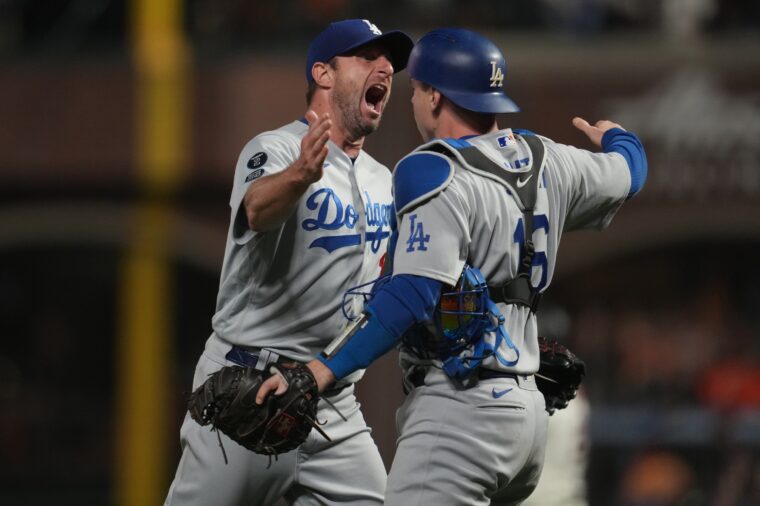
Neville E. Guard-USA TODAY Sports
As collective bargaining agreement talks look to start back up on Sunday, one of the topics that will be at the forefront of discussions is the number of teams in the playoff pool.
In the talks that occurred before MLB canceled games, it seems both sides came to an agreement to increase the teams that make the playoffs from 10 t0 12. That felt inevitable at the beginning of the offseason, but MLB had been pushing for 14 teams.
At end of the day, increasing playoff teams to 12 or 14 is all about money. (MLB and the Major League Baseball Players Association previously agreed to a 16-team playoff for the 2020 season in part because of the short schedule–60 games–and to help recoup money lost due to COVID-19 during 2020.) Thus, the players wanting fewer playoff teams gives the owners an excuse to concede less money, but the players could also use the 14-team format to gain more ground on certain core economic issues, like the amount of money in a pre-arbitration pool or the starting number of the competitive balance tax.
Under the current 12-team format, the top two teams in the American and National Leagues would get a bye from the first round, then the bottom division winner (the third seed) would play the worst Wild Card team (the sixth seed) in a three-game series. The two other Wild Cards would play each other in a three-game series, then we’d eventually get down to the four teams everyone’s been used to in baseball since 1994.
- This would add a maximum of five playoff games (six games total minus the one guaranteed playoff game from the old format) on each side of the bracket and a minimum of three extra games if both series ended in a sweep.
- So, this would create between six and 10 extra playoffs games compared to the old format. That will be a nice chunk of money added to MLB’s revenue, but MLB owners want more.
Under the owners’ 14-team format, only one team would get a bye week, then the two other division winners would get to pick their Wild Card round opponent. The two remaining Wild Card teams not selected by division winners would play each other. Players are vehemently against this format because they don’t see a benefit to winning your division outside of simply getting to pick a playoff opponent.
- This format would add a maximum of eight games (nine games total minus the one guaranteed playoff game from the old format) on each side of the bracket and a minimum of six games if all the series ended in sweeps.
- That’s why MLB wants 14 teams. It’ll be guaranteed anywhere between 12 and 16 extra playoff games, which is where the real national revenue comes in. (ESPN would pay around $100 million for a 14-team playoff, according to ESPN‘s Jeff Passan. ESPN would have exclusive rights to that round. The network would reportedly pay around $85 million for a 12-team playoff.)
But this is where the “ghost win” comes in.
According to recent reports, Max Scherzer and the MLBPA proposed a tweak to the 14-team format that would give the two division winners and the top Wild Card team a “ghost win” in the first round in addition to picking their opponent. All three top seeds in the first round would start their series up 1-0–they’d only need one win to advance, while their opponent would need two wins in a row.
This tilts the meaning of winning your division back to the traditional norm. Division winners at that point would have to lose twice in a row to a Wild Card team to not advance, but it still gives MLB more playoff games with better teams.
- With a “ghost win” format, it’d add a maximum of five games (six games total minus the one guaranteed playoff game from the old format) on each side of the bracket and a minimum of three games if both the Wild Card and ghost-win series end in sweeps
- This is exactly the amount of guaranteed games the 12-game format would provide.
In my opinion, the MLBPA could even go further and say the matchup between the two remaining Wild Card teams in each league would have to play full three-game series, and neither would get a “ghost win.” This would potentially provide at least one more televised playoff game on each side of the bracket.
Ultimately, the “ghost win” format is more attractive to the players than MLB, which is why MLB reportedly shot down the idea. It just doesn’t give MLB the guarantee of more playoff games than it would in a 12-team format. (Hence, why if both remaining Wild Card teams in each league don’t get a ghost win, there would be a couple more playoff games to sell–a happy medium between both proposed playoff formats.)
This all comes down to leverage and concessions. Are the players willing to go to MLB’s proposed full 14-team playoff format if it means getting concessions from the owners on the remainder of the core economic issues? Would the players propose doing a “ghost win” format while also needing more concessions from the owners? Will owners draw a hard line in the sand with what they’re proposing on core economics if playoffs don’t expand beyond 12 teams?
Leverage is what the labor talks have always been about. The playoff format may now be at the center of that leverage as both sides start talking again Sunday.















